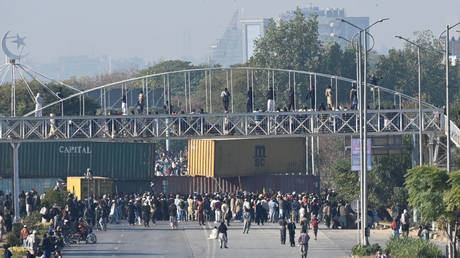ARTICLE AD BOX
VLADIMIR Putin’s powerful fleet of warships armed with hypersonic missiles was given a hero’s welcome by communist Cuba.
Dramatic footage captured Russia’s brand new frigate Admiral Gorshkov arriving to a 21-gun salute as it entered Havana Bay in a massive show of power.
 EPA
EPA East2West
East2West Reuters
Reuters Footage has emerged of the warship engaging in naval drills just 25 miles from the US coast
Footage has emerged of the warship engaging in naval drills just 25 miles from the US coast
The hypersonic missile carrier is leading a four-strong naval flotilla, including a nuclear submarine Kazan and two other naval vessels right on President Joe Biden’s doorstep.
They make a key part of Russia’s nuclear strike force.
The warships are being sent to the Caribbean for military drills in the coming weeks amid boiling tensions with the West.
And after the sabre-rattle in the backyard of Havana, the fleet is also expected to make port calls in Venenzuela – one of America’s long-sworn enemies.
Admiral Gorshkov displayed a huge Z – the sign of Putin’s war in Ukraine which has plunged the world closer to nuclear collision than any time since the Cold War.
And Cubans were seen blasting cannon fire from an 18th-century colonial fort to give the fleet a grand welcome.
Officials denied the modern warship and accompanying Kazan submarine are armed with nuclear missiles in the sabre-rattling visit this week.
However they are understood to be carrying hypersonic Zircon missiles, and like Kalibr and Onyx missiles.
The weapon was designed to arm Russian cruisers, frigates and submarines for use against both enemy ships and ground targets.
Yesterday the flotilla sailed within 25 miles of the US coast in a chilling echo of the Cuban Missile Crisis.
The US has been tracking Russian warships and aircraft that are expected to arrive for the naval exercise and will likely remain in the region through the summer.
Officials said: “As part of Russia’s regular military exercises, we anticipate that this summer, Russia will conduct heightened naval and air activity near the United States.
“These actions will culminate in a global Russian naval exercise this fall.”
The US does not see the move involving a relatively small number of vessels and planes as threatening, but the US Navy will monitor the exercises, the official added.
A despotic Putin sees it as a tit-for-tat for the US, Britain and France supplying Ukraine with missiles for use on his territory.
He suggested that Moscow could take “asymmetrical steps” elsewhere in the world in response to Biden’s call to allow Ukraine to use US-made weapons to strike Russia.
It’s not the first time Russia has sent its ships to the Caribbean.
Last year, the Russian navy’s training class ship Perekop sailed into Havana, while Admiral Gorshkov was spotted in the same harbour in 2019.
The Biden official stressed that the recent move is certainly part of a Russian response to the US’s support for Ukraine but also an attempt for Putin to show off his navy – after losing several ships to Ukrainian strikes.
“This is about Russia showing that it’s still capable of some level of global power projection,” the official said.
Russia’s close relationship with Cuba goes way back in time – as the death of Fidel Castro marked a symbolic end to the Cold War.
The Cuban President who brought the world to the brink of a nuclear war, invited Russian nuclear missiles to be based in Cuba in 1962 – just miles from the US.
Speaking of Castro years later Putin said: “His memory will forever remain in the hearts of the citizens of Russia.”
What was the Cuban Missile Crisis?

By Tom Malley, Foreign News Reporter
THE Cuban Missile Crisis in 1962 is seen as the moment the world came the closest to a nuclear war between the US and the Soviet Union.
On October 27, the American destroyer USS Beale was paroling the US blockade around Cuba.
The ship clocked a Soviet B-59 nuclear submarine lurking beneath the blockade and dropped a series of unarmed depth charges as warning shots to the Soviet sub.
But the submarine captain failed to realise the charges were non-lethal and ordered the ship’s nuclear-tipped torpedo to be prepared for launch.
The mistake would have started World War Three – if only the submarine’s launch protocol didn’t need all commanding officers on board the sub to sign off on it.
Vasili Arkhipov, B-59’s second in command, refused to agree to the strike and eventually talked his captain down.
Without Arkhipov’s cool head on board the sub, the strike would have escalated the Cold War to a full-blown nuclear showdown.
 Russian pro-war Telegram channels have already boasted that the Kazan submarine has ‘guided missile weapons’ on board
Russian pro-war Telegram channels have already boasted that the Kazan submarine has ‘guided missile weapons’ on board Russian flotilla tracked by the US Navy surface and air traffic in the strait between Florida and the Bahamas on Tuesday
Russian flotilla tracked by the US Navy surface and air traffic in the strait between Florida and the Bahamas on Tuesday.png)
 5 months ago
4
5 months ago
4








 English (US)
English (US)